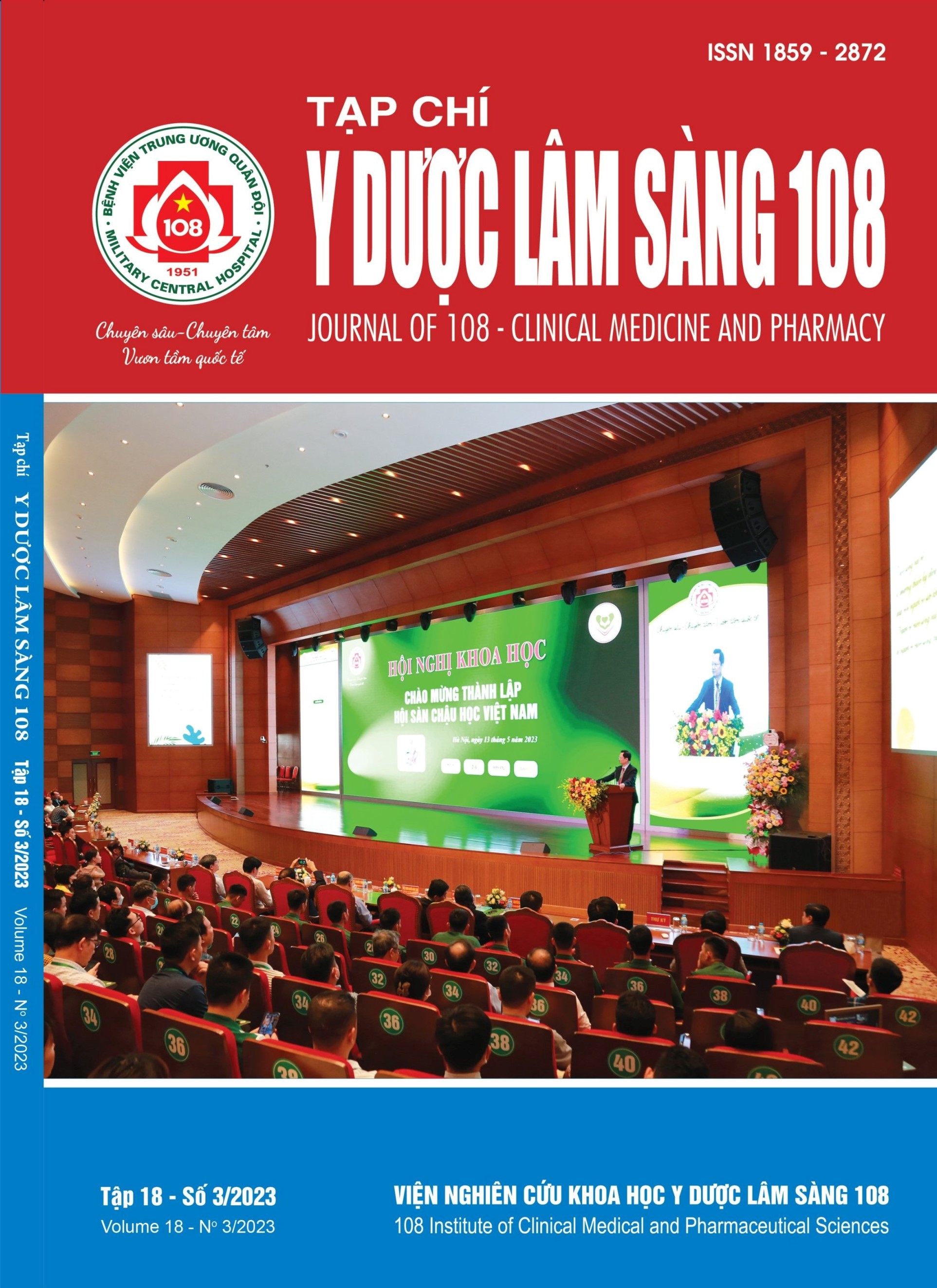Association between plasma zinc concentration and outcomes of patients with sepsis
Main Article Content
Keywords
Abstract
Objective: To describe plasma zinc (Zn) concentration and assess the association between plasma Zn concentration and outcomes of patients with sepsis. Subject and method: A prospective descriptive study was conducted on 125 patients with sepsis treated at 108 Military Central Hospital from November 2019 to February 2021. Plasma Zn concentrations were measured at admission (Zn1) and at day 3 after admission (Zn3), 30-day follow-up of survival and mortality. Result: The rate of Zn1 deficiency was 48.8%. The plasma Zn1 and Zn3 concentrations were 54.0 (37.15-74.4) vs 68.7 (55.3-89.2) µg/dL respectively, p<0.001. The group with SOFA score < 7 points had higher Zn1 concentration than the group with SOFA score ≥ 7 points, p<0.01. There was no statistically significant difference in plasma Zn1 concentrations between the shock group and the non-shock group, between the mechanical ventilation group and non-ventilation group, between the renal group and non-renal failure group, between the liver failure group and non-liver failure group, between the 30-day mortality group and survival group. Conclusion: Zn1 deficiency was common in patients with sepsis. Plasma Zn1 concentration was lower than plasma Zn3 concentration. The group with a higher SOFA score had a lower concentration of Zn1, p<0.01. The 30-day mortality and survival groups had no difference in Zn1 concentrations.
Article Details
References
2. Belsky JB, Wira CR, Jacob V et al (2018) A review of micronutrients in sepsis: the role of thiamine, l-carnitine, vitamin C, selenium and vitamin D. Nutrition Research Reviews 31(2): 281-290.
3. Alker W, Haase H (2018) Zinc and sepsis. Nutrients 10(8).
4. Singer M, Deutschman CS, Seymour CW, Shankar-Hari M, Annane D, Bauer M, Bellomo R, Bernard GR, Chiche JD, Coopersmith CM, Hotchkiss RS, Levy MM, Marshall JC, Martin GS, Opal SM, Rubenfeld GD, van der Poll T, Vincent JL, Angus DC (2016) The third international consensus definitions for sepsis and septic shock (sepsis-3). JAMA 315(8): 801-810.
5. Ayoglu H, Sezer U, Akin M et al (2016) Selenium, copper, zinc, iron levels and mortality in patients with sepsis and systemic inflammatory response syndrome in Western Black Sea Region, Turkey. J Pak Med Assoc 66(4): 447-452.
6. Gaetke LM, McClain CJ, Talwalkar RT et al (1997) Effects of endotoxin on zinc metabolism in human volunteers. Am J Physiol 272(6-1): 952-956.
7. Liuzzi JP, Lichten LA, Rivera S et al (2005) Interleukin-6 regulates the zinc transporter Zip14 in liver and contributes to the hypozincemia of the acute-phase response. Proc Natl Acad Sci U S A 102 (19): 6843-6848.
8. Lichten LA, Liuzzi JP, Cousins RJ (2009) Interleukin-1beta contributes via nitric oxide to the upregulation and functional activity of the zinc transporter Zip14 (Slc39a14) in murine hepatocytes. Am J Physiol Gastrointest Liver Physiol 296(4): 860-867.
9. Moshage H (1997) Cytokines and the hepatic acute phase response. J Pathol 181(3): 257-266.
10. Zhou Z, Wang L, Song Z et al (2004) Abrogation of nuclear factor-kappaB activation is involved in zinc inhibition of lipopolysaccharide-induced tumor necrosis factor-alpha production and liver injury. Am J Pathol 164(5): 1547-1556.
11. Besecker BY, Exline MC, Hollyfield J et al (2011) A comparison of zinc metabolism, inflammation, and disease severity in critically ill infected and noninfected adults early after intensive care unit admission. Am J Clin Nutr 93(6): 1356-1364.
12. Hoeger J, Simon TP, Beeker T et al (2017) Persistent low serum zinc is associated with recurrent sepsis in critically ill patients - A pilot study. PLoS One 12(5): 0176069.
13. Van Nhien N, Khan NC, Yabutani T et al (2006) Serum levels of trace elements and iron-deficiency anemia in adult Vietnamese. Biol Trace Elem Res 111(1-3): 1-9.
14. Laillou A, Pham TV, Tran NT et al (2012) Micronutrient deficits are still public health issues among women and young children in Vietnam. PLoS One 7(4): 34906.
15. Yildiz H (2019) Is it given over importance to serum zinc level in patients with sepsis? Zinc and sepsis. Progress in Nutrition 21(3): 605-610.
16. Shankar AH, Prasad AS (1998) Zinc and immune function: The biological basis of altered resistance to infection. Am J Clin Nutr 68(2): 447-463.
17. Cander B, Dundar ZD, Gul M et al (2011) Prognostic value of serum zinc levels in critically ill patients. J Crit Care 26(1): 42-46.
18. Visalakshy J, Visalakshy J, Surendran S et al (2017) Could plasma zinc be a predictor for mortality and severity in sepsis syndrome? International Journal of Research in Medical Sciences 5(9): 3929-3934.
19. Saleh NY, Abo El Fotoh WMM (2018) Low serum zinc level: The relationship with severe pneumonia and survival in critically ill children. Int J Clin Pract 72(6): 13211.
20. Avinash A, Kumar A, Manish G et al (2018) Trace Elements and Sepsis: Is there a Correlation? International Journal of Medicine and Public Health 8: 133-139.
 ISSN: 1859 - 2872
ISSN: 1859 - 2872
